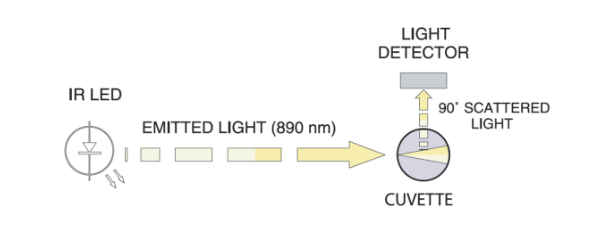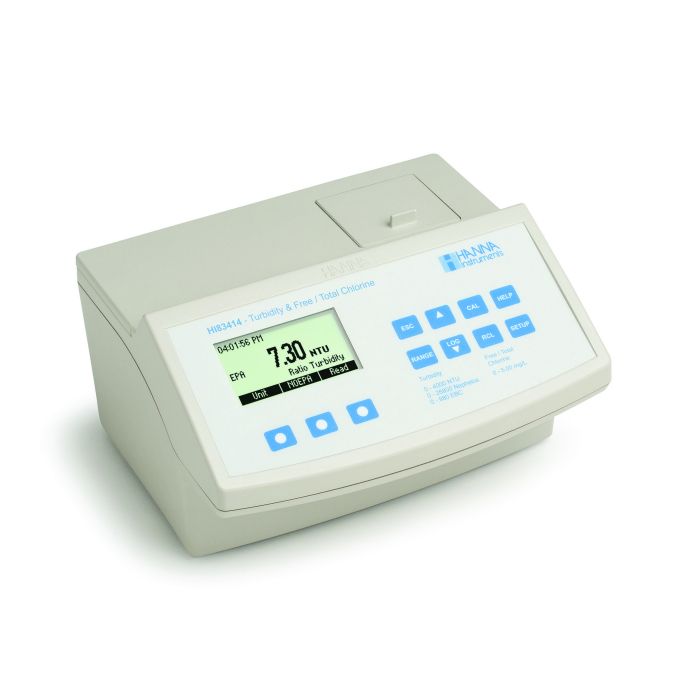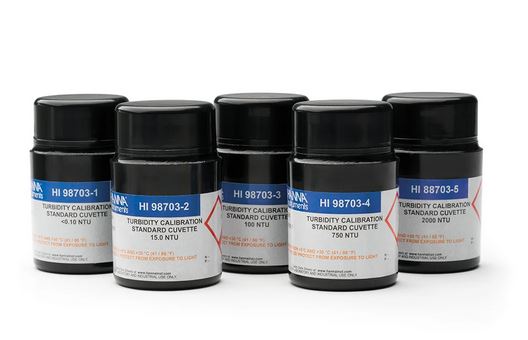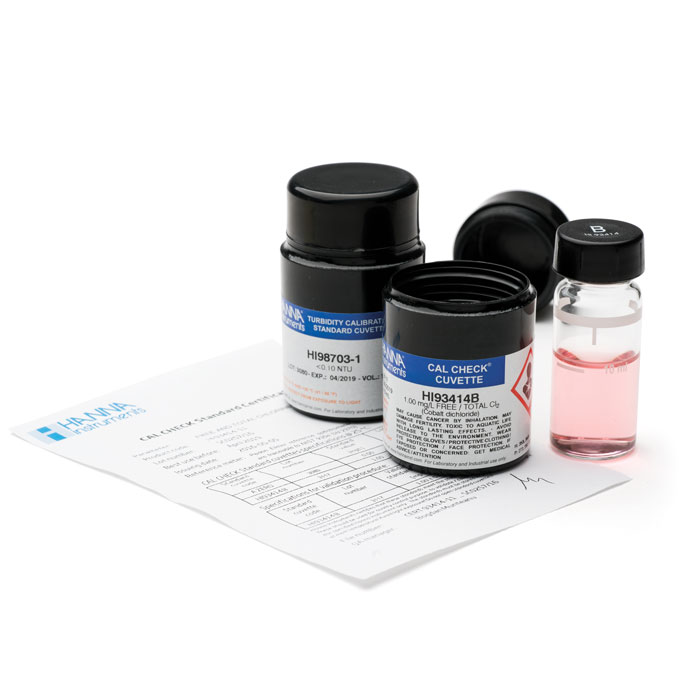EPA Compliant Turbidity meter and Chlorine Meter - HI83414-02
- Compliant to EPA Methods
- Up to ±2% of reading plus 0.02 NTU accuracy
- USB for data transfer
The HI83414 is a multi parameter benchtop meter that measures the most important parameters in drinking water: turbidity and chlorine. The instrument is based on a state-of-the-art optical system which provides accurate results by minimizing stray light and color interferences. Periodic calibration with the supplied standards compensates for any variations in intensity of the tungsten lamp. The colorimeter portion of the meter uses a 525 nm narrow band interference filter for maintaining the proper wavelength in the measurement of free and total chlorine. All measurements are performed with 25 mm round cuvettes composed of special optical glass to ensure maximum repeatability of turbidity and chlorine measurements.
Features at-a-glance
Four Measurement Modes
The HI83414 features four measurement modes including ratio or non-ratio mode for turbidity, free chlorine, and total chlorine. In ratio mode the turbidity is 0.00 to 4000 NTU (Nephelometric Turbidity Units) while in the non-ratio mode the range is 0.00 to 40.0 NTU. The range for free or total chlorine measurements is 0.00 to 5.00 mg/L (ppm) range.
Multiple Turbidity Units of Measure
Turbidity can be displayed as nephelometric turbidity units (NTU), European Brewing Convention units (EBC) or Nephelos units.
EPA Compliant
The HI83414 meets and exceeds the requirements of EPA and Standard Methods both for turbidity and colorimetric chlorine measurements. When the meter is in EPA mode all turbidity readings are rounded accordingly to meet reporting requirements.
Calibration
A two, three, four, or five-point turbidity calibration can be performed by using the supplied (<0.1, 15, 100, 750, and 2000 NTU) standards. Calibration points can be modified if user-prepared standards are used. For free and total chlorine, the CAL Check™ standard can be used for calibration to 1.00 mg/L (ppm).
AMCO AEPA-1 Primary Turbidity Standard
The AMCO AEPA-1 supplied standards are recognized as a primary standard by the USEPA. These non-toxic standards are made of styrene divinylbenzene polymer spheres that are uniform in size and density. The standards are stable and reusable with a long shelf life.
CAL Check ™
With the powerful CAL Check™ function, reliable performance of the chlorine colorimeter can be validated at any moment by using the exclusive HANNA ready-made, NIST traceable standards. All standards are supplied with a Certificate of Analysis (COA) for traceability.
GLP Data
The HI83414 features complete GLP (Good Laboratory Practice) functions that allow traceability of the calibration conditions. Data includes calibration points, date, and time.
Data Logging
Up to 200 measurements can be stored in the internal memory and recalled at any time.
Data Transfer
For further storage or analysis options, logged data can be downloaded to a Windows compatible PC using the USB port and the HI92000 software.
Tutorial Mode
The unique tutorial mode provides additional information to help the user during measurements. When enabled, the instrument displays explanations and a confirmation button when a preparation or other operation has to be performed.
Contextual Help
Contextual help is always available through a dedicated HELP button. Clear tutorial messages and directions are available on-screen to quickly and easily guide users through setup and calibration. The help information displayed is relative to the setting/option being viewed.
Backlit Graphic LCD Display
A graphic LCD display provides an easy to understand, user-friendly interface. All messages are in plain text making them easy to read.
Turbidity is one of the most important parameters used to determine the quality of drinking water. Once considered as a mostly aesthetic characteristic of drinking water, significant evidence exists that controlling turbidity is a competent safeguard against pathogens. In natural water, turbidity measurements are taken to gauge general water quality and its compatibility in applications involving aquatic organisms. The monitoring and treatment or wastewater was once solely based on the control of turbidity. Currently, the measurement of turbidity at the end of the wastewater treatment process is necessary to verify that the values are within regulatory standards.
Turbidity of water is an optical property that causes light to be scattered and absorbed, rather than transmitted. The scattering of light that passes through a liquid is primarily caused by the suspended solids present. The higher the turbidity, the greater the amount of scattered light. Even a very pure liquid will scatter light to a certain degree, as no solution will have zero turbidity.
Drinking water treatment plants that obtain water from surface water are required by the EPA to monitor and report the turbidity. Surface water sources include lakes and rivers. The requirements of the nephelometer and reporting measurements according to EPA Method 180.1 are:
- The applicable range is 0-40 nephelometric turbidity units (NTU)
- Light source: Tungsten lamp operated at a color temperature between 2200-3000°K.
- Distance traversed by incident light and scattered light within the sample tube: Total not to exceed 10 cm.
- Detector: Centered at 90° to the incident light path and not to exceed ±30° from 90°. The detector, and filter system if used, shall have a spectral peak response between 400 nm and 600 nm
The sensitivity of the instrument should permit detection of a turbidity difference of 0.02 NTU or less in waters having turbidities less than 1 unit.
Report results as follows:
|
NTU reading |
Rounded to nearest |
|
0.0 - 1.0 |
0.05 |
|
1 - 10 |
0.1 |
|
10 - 40 |
1 |
|
40 - 100 |
5 |
|
100 - 400 |
10 |
|
400 - 1000 |
50 |
|
>1000 |
100 |
The HI83414 meets and exceeds the meter criteria specied by the EPA Method 180.1 and Standard Methods for the Examination of Water and Wastewater 2130 B.
Principal of Operation
The light beam that passes through the sample is scattered in all directions. The intensity and pattern of the scattered light is affected by many variables, such as wavelength of the incident light, particle size and shape, refractive index, and color. The optical system of the HI83414 includes a tungsten filament lamp, a scattered light detector (90°) and a transmitted light detector (180°). In the ratio turbidimeter range, the microprocessor of the instrument calculates the NTU value from the signals that reach the two detectors by using an effective algorithm that corrects and compensates for interferences of color. The optical system and measuring technique also compensate for fluctuations in lamp intensity, minimizing the need for frequent calibration. In the non-ratio turbidimeter range, the NTU value is calculated from the signal on the scattered light detector (90°). This method offers a high linearity on the low range but is more sensitive to lamp intensity fluctuations. The lower detection limit of a turbidimeter is determined by stray light that is detected by the sensors but not caused by light scattering from suspended particles. The optical system of the HI83414 is designed to have very low stray light, providing highly accurate results for low turbidity samples.

The HI88703-11 AMCO AEPA-1 standards ensure that measurements are traceable to primary reference materials. These standards are used for calibration and performance verification of the HI83414 turbidity meter. Supplied with Certificate of Analysis
- Lot number
- Expiration date
- Standard value @ 25 °C
- Reference meter NIST traceable
Provided storage containers
- Light tight
- Protects from accidental breakage
CAL Check™ standards with certificate
The HI93414-11 free and total chlorine CAL Check™standards are used for calibration and performance verification of the HI83414. Supplied with Certificate of Analysis
- Lot number
- Expiration date
- Standard value @ 25 °C
- Reference meter NIST traceable
Provided storage containers
- Light tight
- Protects from accidental breakage
Specifications
|
sku |
HI83414-01 |
|
NTU ratio Range |
0.00 to 9.99; 10.0 to 99.9; 100 to 4000 NTU 0.0 to 99.9; 100 to 26800 Nephelos 0.00 to 9.99; 10.0 to 99.9; 100 to 980 EBC |
|
NTU ratio Resolution |
0.01; 0.1; 1 NTU 0.1; 1 Nephelos 0.01; 0.1, 1 EBC |
|
NTU non ratio Range |
0.00 to 9.99; 10.0 to 40.0 NTU 0.0 to 99.9; 100 to 268 Nephelos 0.00 to 9.80 EBC |
|
NTU non ratio Resolution |
0.01; 0.1 NTU 0.1; 1 Nephelos 0.01 EBC |
|
NTU Accuracy |
±2% of reading plus 0.02 NTU (0.15 Nephelos; 0.01 EBC) ±5% of reading above 1000 NTU (6700 Nephelos; 245 EBC) |
|
Range Selection |
Automatic |
|
Turbidity Repeatability |
±1% of reading or 0.02 NTU (0.15 Nephelos; 0.01 EBC) whichever is greater |
|
Stray Light |
< 0.02 NTU (0.15 Nephelos; 0.01 EBC) |
|
Free Clorine Range |
0.00 to 5.00 mg/L |
|
Total Chlorine Range |
0.00 to 5.00 mg/L |
|
Chlorine Resolution |
0.01 mg/L from 0.00 to 3.50 mg/L; 0.10 above 3.50 mg/L |
|
Chlorine Accuracy |
±0.02 mg/L @ 1.00 mg/L |
|
Chlorine Detector |
Silicon photocell with 525 nm narrow band interference filters |
|
Chlorine Method |
Adaptation of the USEPA Method 330.5 and Standard Method 4500-Cl G. The reaction between chlorine and DPD reagent causes a pink tint in the sample. |
|
Chlorine Standards |
1 mg/L free chlorine, 1 mg/L total chlorine |
|
Chlorine Calibration |
One-point calibration |
|
Turbidity Light Detector |
Silicon Photocell |
|
Turbidity Method |
Nephelometric method (90°) or Ratio Nephelometric Method (90° & 180°) Adaptation of the USEPA Method 108.1 and Standard Method 2130 B. |
|
Measuring mode |
Normal, Average, Continuous |
|
Turbidity Standards |
<0.1, 15, 100, 750 and 2000 NTU |
|
Calibration |
Two, three, four or five-point calibration |
|
Light Source |
Tungsten filament lamp |
|
Lamp Life |
greater than 100,000 readings |
|
Display |
40 x 70mm graphic LCD (64x128 pixels) with backlight |
|
LOG Memory |
200 records |
|
Serial Interface |
USB |
|
Environment |
0°C (32°F) to 50°C (122°F); max 95% RH non-condensing |
|
Power Supply |
230 V/50 Hz or 115 V/60 Hz 20 W |
|
Auto Shut-Off |
After 15 minutes of non-use |
|
Dimensions |
230 x 200 x 145 mm (9 x 7.9 x 5.7”) L x W x H |
|
Weight |
2.5 Kg (88 oz.) |
|
Warranty |
2 years |
| Fast Shipping | No |
|---|



